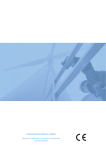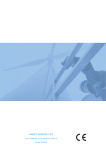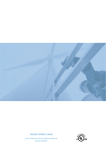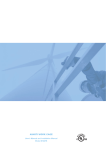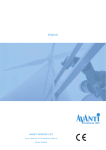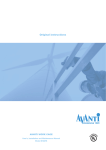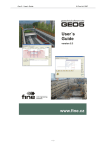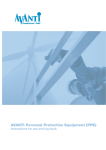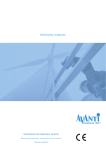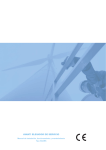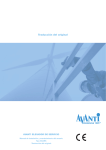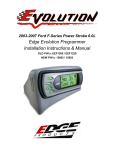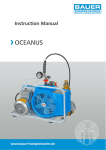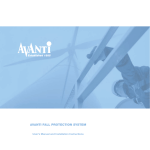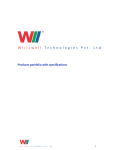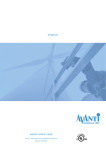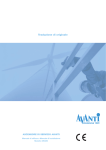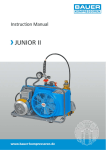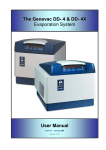Download AVANTI Building Maintenance Unit (BMU) AUS/NZ
Transcript
AVANTI Building Maintenance Unit (BMU) AUS/NZ User’s Manual and Installation Manual Model SHARK Date of publication: 7th CE Edition: February 2008 Manufacturer: AVANTI Wind Systems A/S Høgevej 19 3400 Hillerød Denmark P: +45 4824 9024 F: +45 4824 9124 E: [email protected] I: www.avanti-online.com Sales & Service: USA Avanti Wind Systems, Inc. 5150 S. Towne Drive New Berlin Wisconsin 53151 USA P: +1 (262) 641-9101 F: +1 (262) 641-9161 I: www.avanti-online.com Spain Avanti Wind Systems SL Poligono Industrial Centrovia C/Los Angeles No 88 nave 1 50196 La Muela Spain P: + 34 976 149524 F: + 34 976 149508 I: www.avanti-online.com China Avanti Wind Systems Building 14, Weishi Industrial Park No. 599 Zhongxin Road, Dagang Town Songjiang District, 201614 Shanghai China P: +86 21 5785 8811 F: +86 21 5785 8815 I: www.avanti-online.com Germany Avanti Wind Systems GmbH Weddingstedter Strasse 52 25746 Heide Germany P: +49 48142 1570 - 0 F: +49 48142 1570 - 29 I: www.avanti-online.com Only trained people may use this BMU. This manual must be available to staff at all times during installation and operation. Additional copies are available from the manufacturer upon request. All measurements are indicative only and subject to change without notice. Contents User’s manual 1. Limited warranty . . . . . . . . . . . . . . . . . . . . . . . . . . . . . . . . . . . . . . . . 2. Explanations of symbols used in this manual . . . . . . . . . . . . . . . . . . . . . . 3. Cautions . . . . . . . . . . . . . . . . . . . . . . . . . . . . . . . . . . . . . . . . . . . . . . 4. Description of equipment . . . . . . . . . . . . . . . . . . . . . . . . . . . . . . . . . . . 4.1 Purpose . . . . . . . . . . . . . . . . . . . . . . . . . . . . . . . . . . . . . . . . . . . 4.2 Function . . . . . . . . . . . . . . . . . . . . . . . . . . . . . . . . . . . . . . . . . . . 4.3 Building Maintenance Unit (BMU) models . . . . . . . . . . . . . . . . . . . . . . . 4.4 Temperature . . . . . . . . . . . . . . . . . . . . . . . . . . . . . . . . . . . . . . . . . 4.5 Components . . . . . . . . . . . . . . . . . . . . . . . . . . . . . . . . . . . . . . . . 4.5.1 Cabin overview . . . . . . . . . . . . . . . . . . . . . . . . . . . . . . . . . . . 4.5.2 Cabin with safety gripping device, traction hoist, power cabinet and pendant control . . . . . . . . . . . . . . . . . . . . . . 4.5.3 Technical data for the Building Maintenance Unit (BMU) M, L and XL . . 4.5.4 Drive system, safety gripping device and controls . . . . . . . . . . . . . 4.5.5 Drive wire, safety wire, and guide wire . . . . . . . . . . . . . . . . . . . . . 4.6 Safety devices . . . . . . . . . . . . . . . . . . . . . . . . . . . . . . . . . . . . . . . 4.6.1 Safety brake . . . . . . . . . . . . . . . . . . . . . . . . . . . . . . . . . . . . 4.6.2 EMERGENCY STOP . . . . . . . . . . . . . . . . . . . . . . . . . . . . . . . . 4.6.3 EMERGENCY STOP fixed . . . . . . . . . . . . . . . . . . . . . . . . . . . . 4.6.4 Overwrite “automatic operation” switch . . . . . . . . . . . . . . . . . . . . 4.6.5 Phase monitoring relay . . . . . . . . . . . . . . . . . . . . . . . . . . . . . . 4.6.6 Mechanical lifting force limiter . . . . . . . . . . . . . . . . . . . . . . . . . . 4.6.7 Safety gripping device . . . . . . . . . . . . . . . . . . . . . . . . . . . . . . 4.6.8 Yellow flash . . . . . . . . . . . . . . . . . . . . . . . . . . . . . . . . . . . . . 4.6.9 Sliding door lock . . . . . . . . . . . . . . . . . . . . . . . . . . . . . . . . . . 4.6.10 Limit stop switch . . . . . . . . . . . . . . . . . . . . . . . . . . . . . . . . . . 4.6.10.1 Top limit stop switch . . . . . . . . . . . . . . . . . . . . . . . . . 4.6.10.2 Emergency top limit stop switch . . . . . . . . . . . . . . . . . . 4.6.10.3 Bottom safety stop . . . . . . . . . . . . . . . . . . . . . . . . . . 4.6.10.4 Door stop switch . . . . . . . . . . . . . . . . . . . . . . . . . . . . 4.7 Other risks . . . . . . . . . . . . . . . . . . . . . . . . . . . . . . . . . . . . . . . . . . 5. Daily inspection by the supervisor . . . . . . . . . . . . . . . . . . . . . . . . . . . . . 5.1 Building Maintenance Unit (BMU) . . . . . . . . . . . . . . . . . . . . . . . . . . . . 5.2 Operating area . . . . . . . . . . . . . . . . . . . . . . . . . . . . . . . . . . . . . . . 5.3 Control functions . . . . . . . . . . . . . . . . . . . . . . . . . . . . . . . . . . . . . . 5.4 Automatic operation test . . . . . . . . . . . . . . . . . . . . . . . . . . . . . . . . . 5.5 Remote operation controll . . . . . . . . . . . . . . . . . . . . . . . . . . . . . . . . 5.6 Safety gripping device . . . . . . . . . . . . . . . . . . . . . . . . . . . . . . . . . . . 5.7 Wires and suspension . . . . . . . . . . . . . . . . . . . . . . . . . . . . . . . . . . . 6. Operation - BMU transport . . . . . . . . . . . . . . . . . . . . . . . . . . . . . . . . . . 6.1 Entry and exit . . . . . . . . . . . . . . . . . . . . . . . . . . . . . . . . . . . . . . . . 6.2 Stop/EMERGENCY STOP . . . . . . . . . . . . . . . . . . . . . . . . . . . . . . . . 6.3 Normal operation . . . . . . . . . . . . . . . . . . . . . . . . . . . . . . . . . . . . . . 6.4 Automatic . . . . . . . . . . . . . . . . . . . . . . . . . . . . . . . . . . . . . . . . . . 6.5 Remote operation . . . . . . . . . . . . . . . . . . . . . . . . . . . . . . . . . . . . . 6.6 Lifting force limiter . . . . . . . . . . . . . . . . . . . . . . . . . . . . . . . . . . . . . 7. Manual operation . . . . . . . . . . . . . . . . . . . . . . . . . . . . . . . . . . . . . . . . 7.1 EMERGENCY descent . . . . . . . . . . . . . . . . . . . . . . . . . . . . . . . . . . 7.2 Manual ascent . . . . . . . . . . . . . . . . . . . . . . . . . . . . . . . . . . . . . . . 6 AVANTI BMU for Wind Turbines Page . . . . . . . . . . . . . . . . . . . . . . . . . . . . . . . . . . . . . . . . . . . . . . . . . . . . . . . . . . . . . . . . . . . . . . . . . . . . . . . . 8 9 10 11 11 11 11 11 12 12 . . . . . . . . . . . . . . . . . . . . . . . . . . . . . . . . . . . . . . . . . . . . . . . . . . . . . . . . . . . . . . . . . . . . . . . . . . . . . . . . . . . . . . . . . . . . . . . . . . . . . . . . . . . . . . . . . . . . . . . . . . . . . . . . . . . . . . . . . . . . . . . . . . . . . . . . . . . . . . . . . . . . . . . . . . . . . . . . . . . . . . . . . . . . . . . . . . . . . . . . . . . . . . . . . . . . . . . . . . . . . . . . . . . . . . . . . . . . . . . . . . . . . . . . . . . . . . . . . . . . . . . . . . . . . . . . . . . . . . . . . . . . . . . . . . . . . . . . . . . . . . . . 14 15 17 17 18 18 18 18 18 18 18 18 18 18 19 19 19 19 19 19 20 20 20 20 21 21 21 21 22 22 22 22 22 22 22 23 23 23 8. 9. 10. 11. 12. 13. What to do if the safety gripping device engages . Repair in the event of breakdown . . . . . . . . . . . Out of service . . . . . . . . . . . . . . . . . . . . . . . . Removing wires for replacement . . . . . . . . . . . . 11.1 Parking the Building Maintenance Unit (BMU) . . 11.2 Wire ends . . . . . . . . . . . . . . . . . . . . . . . . 11.3 Removing the lifting wire . . . . . . . . . . . . . . . 11.4 Removing the safety wire . . . . . . . . . . . . . . . Maintenance . . . . . . . . . . . . . . . . . . . . . . . . . 12.1 Yearly inspection . . . . . . . . . . . . . . . . . . . . 12.1.1 Traction hoist . . . . . . . . . . . . . . . . . . 12.1.2 Safety brake . . . . . . . . . . . . . . . . . . 12.1.3 Building Maintenance Unit (BMU) . . . . . 12.1.4 Suspension/wires/cables . . . . . . . . . . 12.1.5 Overload limiter/information signs . . . . . 12.2 Repairs . . . . . . . . . . . . . . . . . . . . . . . . . . Ordering spare parts . . . . . . . . . . . . . . . . . . . . 13.1 Wire/rope . . . . . . . . . . . . . . . . . . . . . . . . 13.2Motor and brake . . . . . . . . . . . . . . . . . . . . 13.3 Electric control . . . . . . . . . . . . . . . . . . . . . 13.4 Safety brake . . . . . . . . . . . . . . . . . . . . . . . 13.5 Rating plates and information signs . . . . . . . . . . . . . . . . . . . . . . . . . . . . . . . . . . . . . . . . . . . . . . . . . . . . . . . . . . . . . . . . . . . . . . . . . . . . . . . . . . . . . . . . . . . . . . . . . . . . . . . . . . . . . . . . . . . . . . . . . . . . . . . . . . . . . . . . . . . . . . . . . . . . . . . . . . . . . . . . . . . . . . . . . . . . . . . . . . . . . . . . . . . . . . . . . . . . . . . . . . . . . . . . . . . . . . . . . . . . . . . . . . . . . . . . . . . . . . . . . . . . . . . . . . . . . . . . . . . . . . . . . . . . . . . . . . . . . . . . . . . . . . . . . . . . . . . . . . . . . . . . . . . . . . . . . . . . . . . . . . . . . . . . . . . . . . . . . . . . . . . . . . . . . . . . . . . . . . . . . . . . . . . . . . . . . . . . . . . . . . . . . . . . . . . . . . . . . . . . . . . . . . . . . . . . . . . . . . . . . . . . . . . . . . . . . . . . . . . . . . . . . . . . . . . . . . . . . . . . . . . . . . . . . . . . . . . . . . . . . . . . . . . . . . . . . 24 25 28 28 28 28 28 28 28 29 29 29 29 29 30 30 31 31 31 31 31 31 Installation manual 1. Assembling SHARK cabin . . . . . . . . . . . . . . . . . . . . . 1.1 Parts list - SHARK sliding door . . . . . . . . . . . . . . . . 1.2 Parts list - SHARK double door . . . . . . . . . . . . . . . . 1.3 Parts list - SHARK M . . . . . . . . . . . . . . . . . . . . . . 2. Fitting of wires . . . . . . . . . . . . . . . . . . . . . . . . . . . . . 2.1 Tower top . . . . . . . . . . . . . . . . . . . . . . . . . . . . . 2.2 Wire positioning measurements . . . . . . . . . . . . . . . . 2.3 Securing the guide wire - ground level . . . . . . . . . . . . 2.3.1 Method 1: Wedge anchor . . . . . . . . . . . . . . . 2.3.2 Method 2: Tripod . . . . . . . . . . . . . . . . . . . . 2.3.3 Method 3: Steel beam . . . . . . . . . . . . . . . . . 2.3.4 Tensioning of the guide wires Ø12 mm . . . . . . . 2.4 Electrical connections . . . . . . . . . . . . . . . . . . . . . . 2.4.1 Power supply . . . . . . . . . . . . . . . . . . . . . . . 2.4.2 Supply cable . . . . . . . . . . . . . . . . . . . . . . . 2.4.3 Power connection . . . . . . . . . . . . . . . . . . . . 2.5 Installation of drive and safety wire in BMU . . . . . . . . . 2.5.1 Drive wire installation . . . . . . . . . . . . . . . . . . 2.5.2 Safety wire installation . . . . . . . . . . . . . . . . . 2.6 Securing the drive and safety wire . . . . . . . . . . . . . . 2.6.1 Drive wire contra weight . . . . . . . . . . . . . . . . 2.6.2 Safety wire method 1: Wedge anchor with spring . 2.6.3 Safety wire method 2: Push spring . . . . . . . . . . 2.6.4 Safety wire method 3: Steel beam with spring . . . 2.7 Wire fix alignment . . . . . . . . . . . . . . . . . . . . . . . . 2.8 Adjustment of top stop disc . . . . . . . . . . . . . . . . . . 3. Danger zone! sticker . . . . . . . . . . . . . . . . . . . . . . . . . 4. Disassembling . . . . . . . . . . . . . . . . . . . . . . . . . . . . . 5. Inspection before initial use . . . . . . . . . . . . . . . . . . . . . . . . . . . . . . . . . . . . . . . . . . . . . . . . . . . . . . . . . . . . . . . . . . . . . . . . . . . . . . . . . . . . . . . . . . . . . . . . . . . . . . . . . . . . . . . . . . . . . . . . . . . . . . . . . . . . . . . . . . . . . . . . . . . . . . . . . . . . . . . . . . . . . . . . . . . . . . . . . . . . . . . . . . . . . . . . . . . . . . . . . . . . . . . . . . . . . . . . . . . . . . . . . . . . . . . . . . . . . . . . . . . . . . . . . . . . . . . . . . . . . . . . . . . . . . . . . . . . . . . . . . . . . . . . . . . . . . . . . . . . . . . . . . . . . . . . . . . . . . . . . . . . . . . . . . . . . . . . . . . . . . . . . . . . . . . . . . . . . . . . . . . . . . . . . . . . . . . . . . . . . . . . . . . . . . . . . . . . . . . . . . . . . . . . . . . . . . . . . . . . . . . . . . . . . . . . . . . . . . . . . . . . . . . . . . . . . . . . . . . . . . . . . . . . . . . . . . . . . . . . . . . . . . . . . . . . . . . . . . . . . . . . . . . . . . . . . . . . . . . . . . . . . . . . . . . . . . . . . . . . . . . . . . . . . . . . . . . . . . . . . . . . . . . . . . . . . . . . . . . . . . . . . . . . . . . . . . . . . . . . . . . . . . . . . . . . . . . . . . . . . . . . . . . . . 33 34 37 40 44 44 45 46 46 47 47 47 47 47 48 48 49 49 49 50 50 50 51 51 52 53 53 53 54 . . . . . . . . . . . . . . . . . . . . . . . . . . . . . . . . . . . . . . . . . . . . . . . . . . . . . . . . . . . . . . . . . . . . . . . . . . . . . . . . . . . . . . . . . . . . . . . . . . . 55 59 64 Appendix A: Regulation of overload limiter . Appendix B: Annual inspection test report . Appendix C: Report of defects . . . . . . . . . . . . . . . . . . . . . . . . . . . . . . . . . . . . . . . . . . . . . . . . . . . . . . . . . . . . . . . . . . . . . . . . . . . . . . . . . . . . . . . . . . . . . . . . . User’s Manual 7 1. Limited Warranty Avanti Wind Systems A/S guarantees that commencing from the date of shipment to the Customer and continuing for a period in excess of 365 days thereafter, or the period set forth in the standard Avanti warranty, the Avanti Building Maintenance Unit (BMU) (“Product”) described in this Manual will be free from material and workmanship defects during normal use and service when installed and operated in accordance with the provisions of this Manual. This warranty is made only with respect to the original user of the Product. The sole and exclusive remedy and the entire liability of Avanti under this limited warranty, shall be, at the option of Avanti, a replacement of the Product (including incidental and freight charges paid by the Customer) with a similar new or reconditioned Product of equivalent value, or a refund of the purchase price if the Product is returned to Avanti, freight and insurance prepaid. The obligations of Avanti are expressly conditioned upon return of the Product in strict accordance with Avanti’s return procedures. This warranty shall not apply if the Product (i) has been altered without the authorization of Avanti or its authorized representative; (ii) has not been installed, operated, repaired, or maintained in accordance with this Manual or other instructions from Avanti; (iii) has been subjected to abuse, neglect, casualty, or negligence; (iv) has been furnished by Avanti to Customer without charge; or (v) has been sold 8 AVANTI BMU for Wind Turbines on an “AS-IS” basis. Except as specifically set forth in this Limited Warranty, ALL EXPRESS OR IMPLIED CONDITIONS, REPRESENTATIONS AND WARRANTIES, INCLUDING, BUT NOT LIMITED TO, ANY IMPLIED WARRANTY OR CONDITION OF MERCHANTABILITY, FITNESS FOR A PARTICULAR PURPOSE, NON-INFRINGEMENT, SATISFACTORY QUALITY, COURSE OF DEALING, LAW, USAGE OR TRADE PRACTICE ARE HERBY EXCLUDED TO THE MAXIMUM EXTENT PERMITTED BY APPLICABLE LAW AND ARE EXPRESSLY DISCLAIMED BY AVANTI. IF, PURSUANT TO ANY APPLICABLE LAW, TO THE EXTENT AN IMPLIED WARRANTY CANNOT BE EXCLUDED AS PROVIDED IN THIS LIMITED WARRANTY, ANY IMPLIED WARRANTY IS LIMITED IN TIME TO THE SAME DURATION AS THE EXPRESS WARRANTY PERIOD SET FORTH ABOVE. BECAUSE SOME STATES DO NOT PERMIT LIMITATIONS ON THE DURATION OF IMPLIED WARRANTIES, THIS MAY NOT APPLY TO A GIVEN CUSTOMER. THIS LIMITED WARRANTY GIVES THE CUSTOMER SPECIFIC LEGAL RIGHTS, AND THE CUSTOMER MAY HAVE OTHER LEGAL RIGHTS UNDER APPLICABLE LAWS. This disclaimer shall apply even if the express warranty fails with regard to its original purpose. 2. Explanation of symbols used in this manual Symbol Signal word Meaning Possible injury if not observed IMMEDIATE or possibly imminent danger: Death or severe injury! Safety instructions STOP DANGER! DANGER! CAUTION! IMMEDIATE or possibly imminent danger of hazardous voltage: Death or severe injury! Potentially hazardous situation: Light injury or material damage. Warning! Potentially dangerous situation: Damage to equipment or workplace Important! Useful tips for optimum working procedure None Additional instructions Order Reference to written specification/documentation User’s Manual 9 3. Cautions CAUTION! Avoid injury – follow all instructions! a)Installation and/or maintenance and/or operation of the Building Maintenance Unit (BMU) and its suspension may be performed only by qualified personnel, hired by the employer for the job at hand. b)The personnel must be at least 18 years of age. The staff must be familiar with the relevant accident prevention instructions and must have received proper training in these. c)Personnel is obliged to read and understand this User’s Manual. d)A copy of the User’s Manual must be handed out to the personnel and must always be available for reference. e)If more than one person is entrusted with one of the above tasks, the employer shall appoint a supervisor in charge of the operation. STOP DANGER! f)Whenever installation, ascending, and/or descending involves a danger of falling, all personnel inside the danger area must wear personal protective equipment which will prevent them from falling by means of a safety system secured to the building. g)Only fault-free suspension devices, cabin components, traction hoist equipment, safety brake gripping devices, original traction hoist wires and stopping devices may be used. h)Electrical connection of the system must be made in accordance with EN 60204-1. i)Prior to mounting, all parts must be tested to ensure their completeness and full functionality. j)Self-locking nuts must be used at all times, and the following must always be observed: - The screw must extend from the nut by at least half of the thread diameter. - The nut may not be used once it has become possible to loosen by hand! k)Prior to mounting the suspension system, ensure that the building sections involved will be able to 10 AVANTI BMU for Wind Turbines carry the load. l)If any damage or faults are found during operation, or if circumstances arises which may jeopardize safety: – Immediately interrupt the work in progress and notify the supervisor or employer! m)All tests/repairs of electrical installations may only be performed by qualified electricians. n)All repairs to the traction hoist, safety brake gripping device and the system’s supporting parts may be performed only by qualified fitters. o)If any supporting parts are repaired or replaced, the operational safety of the system must be tested and verified by an expert. p)Use of non-original parts, in particular use of wires other than the prescribed original traction hoist wire will render the manufacturer’s warranty void and the CE approval invalid. q)No modification, extension or reconstruction of the Building Maintenance Unit (BMU) is allowed without the manufacturer’s prior written consent. r)No warranty is provided against damage resulting from reconstruction or modification of equipment or use of non-original parts which are not approved by the manufacturer. s)Before using the BMU, an inspection by the authorised security organisation must be carried out. t) The BMU must be inspected at least once a year by an expert trained by AVANTI. The traction hoist and saftey brake must be overhauled at an authorised workshop and furnished with a new certificate following every 250 hours of operation. u) T he Building Maintenance Unit (BMU) may not be used by a person under the influence of alcohol or drugs as this may seriously jeopardize working safety. he tower owner must verify the need T for third party BMU in spections with the local authority and comply with the standards specified. 4. Description of equipment 4.1 Purpose 4.3 BMU models The Building Maintenance Unit (BMU) described in this User’s Manual serves the following purposes: - transportation of staff and material inside wind turbine systems, lattice towers for wind turbines, and telecommunication towers. - transportation for mounting, inspection and repairs. This User’s Manual and Installation Manual describe the following models: The Building Maintenance Unit (BMU) may be used to transport two persons plus their tools and equipment to the most convenient height for performing work on the tower. • S HARK XL sliding door with 320 kg lifting capacity. The Building Maintenance Unit (BMU) is designed for permanent installation in one specific tower. The BMU is not designed for use - in silos, - at drilling sites, - as a permanently installed facade BMU, - as a crane BMU, - in environments with explosion hazards. • S HARK M sliding door with 240 kg lifting capacity • S HARK L sliding/double door/4-door with 240/320 kg lifting capacity 4.4 Temperature Operating temperature -15ºC - +60ºC. Survival temperature -25ºC - +80ºC. Low temperature kit is also available. Operational temperature for low temperature kit -25ºC - +40ºC. 4.2 Function The BMU uses a traction hoist for ascending and descending on a wire secured to the building. Two safety brake safety gripping devices secure the BMU to a separate safety wire. Upward and downward travel is controlled from inside the BMU in manual mode, from the remote control transmitter in remote mode (optional), or from the outside in the automatic mode (optional). A lifting force limiter prevents upward travel in the event of an overload of the traction hoist. Two guide wires on either side of the BMU prevent the BMU from swivelling/tilting. User’s Manual 11 4.5 Components 4.5.1 Cabin overview Fig. 1a SHARK L sliding door Fig. 1b SHARK L double door 3 1 Cabin 2 Sliding door 3 Drive and safety wires 4 Guide wire 5 Wire guides 6 Bottom safety stop (For details see pages 14-19) 12 AVANTI BMU for Wind Turbines 3 2 1 1 2 4 4 5 5 6 6 1 Cabin 2 Double door 3 Drive and safety wires 4 Guide wire 5 Wire guides 6 Bottom safety stop (For details see pages 14-19) Fig. 1c SHARK L 4-door version Fig. 1b SHARK M sliding door 3 3 2 2 1 1 Cabin 2 4 door 3 Drive and safety wires 4 Guide wire 5 Wire guides 6 Bottom safety stop (For details see pages 14-19) 1 4 4 5 5 6 6 1 Cabin 2 Sliding door 3 Drive and safety wires 4 Guide wire 5 Wire guides 6 Bottom safety stop (For details see pages 14-19) User’s Manual 13 4.5.2 C abin with safety gripping device, traction hoist, electrical control box and pendant control Fig. 2 2 3 4 5 12 6 8 7 10 9 1 14 13 11 1 Cabin 2 Traction hoist 3 Electrical control box 4 Anchor point 5Safety brake safety gripping device 6 Cable connection (behind the BMU) 14 AVANTI BMU for Wind Turbines 7EMERGENCY STOP button fixed (Inside cabin optional) 8 Pendant control 9Overwrite automatic operation switch (optional) 10 Door stop switch 11 Bottom safety stop 12 Shackle 13EMERGENCY limit stop switch 14 Operation limit stop switch (For details see pages 15-19) 4.5.3 Technical data for the BMU M, L and XL Fig. 3a Dimensions, sliding door Shark M lifting capacity: • Motor X402P 240 kg • Motor A500 240 kg (max 1 person) H Shark L lifting capacity: • Motor X402P 240 kg • Motor A500 240 kg (max 2 person) • Motor X502P 320 kg • Motor A500 320 kg (max 2 person) Shark XL lifting capacity: • Motor X402P 240 kg • Motor A500 240 kg (max 2 person) • Motor X502P 320 kg • Motor A500 320 kg (max 3 person) Weight of BMU: M: kg 90 L: kg 110 XL: kg 120 F The weight of the power supply cable should be added to the weight of the BMU (approx. 0.23 kg per m). B A Standing height: Under spine: 1980 mm Under traction hoist: 2100 mm D C Sliding door opening: M: 335 mm X - XL: 550 mm E N G Dimensions in mm: Shark A B C D E F G1) N H M 380 600 600 650 400 75 790/660 630 2980 L 380 960 600 650 475 75 1150/1020 990 2980 XL 480 960 800 850 475 75 1150/1020 990 2980 1) Standard wire guide/narrow wire guide. (Details p. 52) User’s Manual 15 Fig. 3b Dimensions, double door Lifting capacity: • Motor X402P 240 kg • Motor A500 240 kg (max 2 persons) • Motor L502P 320 kg • Motor A500 320 kg (max 3 persons) Weight of BMU: L: kg 115 XL: kg 125 Standing height: Under spine: 1980 mm Under traction hoist: 2100 mm F H The weight of the power supply cable should be added to the weight of the BMU (approx. 0.23 kg per m). B A D C E N G Dimensions in mm: Shark A B C D E F G1) N H L 380 960 600 650 475 1100 1150/1020 990 2980 1) Standard wire guide/narrow wire guide. (Details p. 52) 16 AVANTI BMU for Wind Turbines 4.5.4 Drive system, safety gripping device and controls Fig. 4 Traction hoist A500 X402P 1 1 2 2 3 3 4 4 1Insertion point for brake lever 2 Motor 3Wire traction w/overload protection 4Drive system/ gearbox Fig. 5 Safety brake BSO 504E ASB500 5 5 8 9 6 Fig. 6 Electrical control box For A500 For X402P 10 11 9 6 7 Fig. 7 a Pendant control 10Hand/ Automatic 11Ready lamp “ON” 12Override bottom limit stop (key switch) 12 8 5Control handle/ brake lever 6Safety brake stop button 7Inspection window 8 Safety wire 9Connection cable 7 Fig. 7 b Remote control 16 13 14 13EMERGENCY STOP button 14 UP 15 DOWN 16 On/Off 17Connection cable for control box 15 10 11 17 12 Table 1. Traction hoist Traction Unit weight Measures/dimensions hoist wire Ø approx. a b c Lifting capacity Wire speed Effect Rated current Traction hoist type Kg m/min kW A mm Kg mm mm mm X402P/400V 400 18 1.5 3.5 8 29.5 485 250 250 X402P/690V 400 18 1.5 2.0 8 29.5 485 250 250 L502P/400V 500 18 1.5 3.5 8 29.5 485 250 250 L502P/690V 500 18 1.5 2.0 8 29.5 485 250 250 A500/400V 500 18 1.5 4.5 8.3 39 447 244 279 A500/690V 500 18 1.5 3 8.3 39 447 244 279 Hoist Table 2. Safety brake Safety gripping device Safety brake type BSO 504 E BSO 1004 E 1) ASB500 1) Lifting capacity To max. wire speed Traction hoist wire Ø Unit weight approx. kg m/min mm 400 18 500 500 Measures/dimensions a b c kg mm mm mm 8 4.7 214 121 131 18 8 4.7 251 140 131 18 8.3 7 269 176 101 Motor L502P must be installed with BSO 1004 E Table 3. Drive wire, safety wire and guide wire Wire type X402P / BSO504 E L502P / BSO1004 E Guide Wire A500 / ASB500 Wire diameter 8mm, 4x26 or 5x19 12mm 8.3mm, 5x26 Surface treatment galvanised galvanised galvanised Mark/ feature 1 red string / cord Min. break resistance - 85 kN Shackle,2t 51.5 kN 2 t shackle, Form C none 39.7 kN Attached with 2 t shackle, Form C Anchoring Tighten to - - Min. every 35m 2 to 4 kN - - User’s Manual 17 4.6Safety devices 4.6.1Safety brake Electromagnetic spring-loaded brake which engages automatically –on releasing the direction selector and – following a power failure. 4.6.2 EMERGENCY STOP When the red EMERGENCY STOP (pendant control) switch is pushed in an emergency, all control is interrupted. After remedying the fault, control is reactivated by turning the switch clockwise, until it pops out again. 4.6.3EMERGENCY STOP fixed (optional) Only in BMUs with AUTOMATIC function installed. A backup switch to the pendant control EMERGENCY STOP switch is situated on the right hand panel inside the BMU. For function, see above (Fig. 9). 4.6.4Overwrite “automatic operation” switch A switch situated inside the pendant control holder. It prevents the BMU from being controlled from the inside when the control is in automatic mode. 4.6.5 Phase monitoring relay With three-phase power operation, the phase monitoring relay will interrupt operation when a faulty phase sequence is detected, preventing the faulty assignment of UP/DOWN direction power, which deactivates the limit stop switch and the lifting force limiter functions. Solution: Have an electrician switch two of the phases in the electric plug. 4.6.6 Mechanical lifting force limiter The lifting force limiter is built into the wire traction system and will prevent upward travel in the event of an overload. A warning signal (buzzer) is triggered which will stop only when the cause of the overload has been removed. Possible reasons for activation of the limiter: - The BMU is overloaded or - The BMU encounters an obstacle during upward travel. Operator intervention: - Reduce the load to below the overload limit, or - lower the BMU until it is free of the obstacle and remove the obstacle before using the BMU again. 18 AVANTI BMU for Wind Turbines 4.6.7 Safety gripping device Hoistable personal transportation means must be equipped with 2 safety gripping devices which will prevent the load from falling. Safety brake Type BSO + ASB The safety brake BSO + ASB safety gripping devices are opened manually (Fig. 8). Fig. 8 Safety brake BSO ASB500 Fig. 9 Emergency stop and override bottom stop switch Fixed Emergency stop button Window Stop button ON/Locked OFF/Open Override “automatic operation” switch Fig. 9a Yellow flash The speed of the safety wire passing through the device is continuously monitored, and the jaws automatically close in the event of sudden excessive speed. This protects the BMU from a) Lifting wire breaks and b) Hoist failures. The safety gripping device can also be engaged manually in an emergency by pressing the Emergency stop button. The window is used to monitor the centrifugal force mechanism’s function during operation. For information on required intervention when the safety gripping device engages, see section 8 on page 24. 4.6.8 Yellow flash An optional set of flashes can be mounted on the top and at the base of the BMU. The flashes indicate when the BMU is in movement. 4.6.9 Sliding door lock Sliding doors are closed by pushing the steel tap on the door into the red door lock switch. The door is unlocked by pushing the black button on the red door lock switch. From the outside the same button is reached through a hole. 4.6.10 Limit stop switch 4.6.10.1 Top limit stop switch At the top of the cabin frame a top limit stop switch will stop upward travel when activated (Fig. 10). Downward travel will still be possible. A top stop disc which activates the top stop switch is installed below the lifting wire attachment. (Fig. 5 page 44) ATTENTION! When the top limit stop switch is engaged, activate the DOWN switch until the top limit stop switch is released. 4.6.10.2 EMERGENCY top limit stop switch Deactivates control if the top limit stop switch fails (Fig. 10). Manual downward travel is possible. and safety brake safety gripping device have not been specifically determined for the construction in question: The safety function of the safety brake will only work if the safety wire between the wire attachment and the safety brake is tight (no loose wires!). Therefore, any loose safety wire must be coiled with minimum 3 wire strips approx. 20 cm below the access platform (See page 51). Anchor points The Avanti BMU is equipped with one or two anchor points (Fig. 2, page 14). During operation personnel should hook themselves up to the Anchor point. An optional safety bar can also be mounted. STOP Fig. 10 CAUTION! Do not use the BMU until the top limit stop switch fault has been rectified. 4.6.10.3 Bottom safety stop The bottom safety stop switch (Fig. 11) stops downward travel if the BMU – encounters an obstacle or – touches the ground. Upward travel will be possible, for instance to remove the obstacle. In order to put the BMU on the ground, the contact plate’s operation can be bypassed with the key switch in the control box. If it is possible to enter underneath the BMU a double button safety stop must be installed. (See page 36 of the installation manual). Stop switch, normal operation Emergency stop switch Fig. 11 Bottom safety stop 4.6.10.4 Door stop switch Sliding door: The red door lock switch will interrupt control if the door is not closed properly. Double door: A switch (Fig. 12) will interrupt control if the door is not closed properly. Fig. 12 EMERGENCY STOP button 4.7 Other risks (hazards) CAUTION! The following risks relating to the traction hoist Door limit stop switch (In door frame) User’s Manual 19 5. Daily inspection by the supervisor 5.1 BMU a)Before each operation, ensure that the traction hoist, the safety brake and all auxiliary components (stoppers, wire guide wheels, etc.) are mounted in accordance with the specifications and without any noticeable defects. b)Check whether the drive, and safety wires are fed correctly around the two wire guide wheels. c)Wire ends (of 3 m or more in length) must be coiled separately at the floor and tied with strips in at least 3 places. d)Check lifting capacity: (see the rating plate or section 4.5.3) – the extra load (persons and materials!) must not exceed the maximum rated lifting capacity. d)Bottom safety stop. Lower the BMU; it should stop before the rubber feet of the cabin reach the tower ground level. When the “bypass switch” is activated, it should be possible to lower the BMU all the way to the ground. e)Door stop switch: Open the doors – it should not be possible to move the BMU upwards or downwards. f)If the optional AUTOMATIC function is installed. Set the HAND/AUTOM. selector to AUTOM. When holding the handle, the BMU should remain still when the UP or DOWN buttons are activated. Warning! If any faults occur during work, - stop working, - if required secure the workplace and - rectify the fault! (See page 25). 5.2 Operating area a)Ensure that there are no obstacles within the BMU’s operating area which may obstruct the travel of the cabin or cause the cabin to hit the ground. b)Ensure that all relevant and required protection measures below the cabin are in place. Such measures could include pent roofs or barriers to protect the staff from falling objects. DANGER! STOP Make sure that nobody is exposed to danger below the BMU, for instance from falling parts. Suitable measures: Pent roof or barriers. Fig. 13 Electrical control box X402P/L502P HAND/ AUTOM. (Optional) 5.3 Control function a)Close the doors. Press the EMERGENCY STOP button. The BMU should remain still when the UP/DOWN button is pressed. To restart, turn the EMERGENCY STOP button clockwise. If a FIXED EMERGENCY STOP button is installed (Fig. 9) test as above. b)Test the Operation limit stop switch: During upward travel, press the switch manually, and the BMU should stop immediately. Pressing the limit stop switch should enable the BMU to travel down again. c)Test the EMERGENCY limit stop switch: During upward travel, press the switch manually, and the BMU should stop immediately. Neither upward nor downward travel should now be possible. 20 AVANTI BMU for Wind Turbines A500 Ready lamp “ON” Override bottom safety stop Pendant control EMERGENCY STOP UP DOWN 5.4 Automatic operation test Perform this inspection only if the AUTOMATIC function is installed. a)Press EMERGENCY STOP button on the pendant control. Turn the HAND/AUTOM. switch on the electrical control box to the right to activate automatic operation. (Fig. 13 page 20) b)Deactivate the EMERGENCY STOP button by turning the button clockwise. (Check the EMERGENCY STOP button fixed is deactivated.) The BMU should stand still. c)DO NOT try to activate the override “automatic operation” switch. d)With the doors closed, press the UP and DOWN buttons. Neither upward nor downward travel should be possible (Switch in pendant control holder blocks the operation). e)Press the EMERGENCY STOP button on the pendant control. f)Place the pendant control in its holder so it is operational from the outside. g)Leave the cabin and close the door. h)Deactivate the EMERGENCY STOP button. The BMU should stand still. i)Press the UP button. The BMU should travel upwards. j)Press the EMERGENCY STOP button. The BMU stops. k)Turn the EMERGENCY STOP button clockwise and press the DOWN button. The BMU should travel downwards until the EMERGENCY STOP bottom stops the BMU. l)Remove the pendant control from holder. m)Return the HAND/AUTOM. button to HAND. n)Check that the UP and DOWN buttons work again. o)DO NOT try to activate the override “automatic operation” switch. 5.5 Remote operation test Perform this inspection only if the remote control function is installed. a)Set the electrical control box switch HAND/ AUTOM to hand (fig 7 a). b)On top of the remote operation receiver switch the device on (fig 7 b). c)Press the up arrow on the remote operation transmitter. The BMU should ascend. d)Press the down arrow on the remote operation transmitter. The BMU should descend. e)Once the test is complete, switch the remote operation function off. 5.6 Safety gripping device a)Engage the safety brake by pressing the safety brake stop button - the handle should jump to the “ON” position (Fig. 8 page 18). b)Reopen the safety brake by pressing down on the lever – the lever must engage. c)During operation, regularly monitor the centrifugal force regulator relay’s rotation by looking through the window. 5.7 Wires and suspension Fig. 13b Emergency stop button a)During operation: Check the lifting and safety wires for free passage through hoist and safety gripping device. b)When the BMU is at the top landing, inspect the wire attachment and all the building sections that suspend the BMU. Override “automatic operation” switch User’s Manual 21 6. Operation - BMU transport Transportation of people in AUTOM. mode is forbidden. 6.1 Entry and exit To ensure safe entry and exit: a)Lower the BMU onto the access platform until the contact plate is activated and the cabin stops, or: bring the BMU to a height corresponding to the correct level for exiting from the wind turbine’s platform. b)Open the door and exit/enter the BMU through the door/over the cabin railing. 6.2 Stop/EMERGENCY STOP a)Release the direction selector; the BMU should stop If it does not: b)Push the EMERGENCY STOP switch, and all controls should be disabled. Open the door and enter/exit the BMU through the door/ over the cabin railing. 6.3 Normal operation a)Turn the red EMERGENCY STOP switch on the control box clockwise and the switch should pop out (Fig. 13 page 20). Do likewise with EMERGENCY STOP fixed (Fig. 9page 18). b)To go up or down, push and hold the direction selector in the relevant direction. c)To place the BMU on the floor after the bottom safety stop has stopped the BMU. - Turn the override bottom safety stop switch (Fig. 6 page 17) clockwise and hold. - Press the DOWN button until the BMU rests on the floor, then release. 6.4 Automatic Only in BMUs with the AUTOMATIC function installed. a)Press the EMERGENCY stop button on the 22 AVANTI BMU for Wind Turbines pendant control. Turn the HAND/AUTOM. switch on the power cabinet to activate automatic operation. b) Close door. c)Press the UP or DOWN button respectively and the cabin starts ascending/descending. d)Remove the pendant control from its holder. e)Return the HAND/AUTOM. button to HAND. 6.5 Remote operation a)Set the electrical control box switch to hand (fig. 6). b)On top of the remote operation receiver switch the device on (fig. 7 b). c)For ascending press the up arrow on remote operation transmitter. d)For descending press the down arrow on remote operation transmitter. e)Once the operation is complete, switch the remote operation function off. 6.6 Lifting force limiter a)In case of an overload, the BMU’s upward travel should be blocked, and a buzzer should sound in the connection cabinet. STOP DANGER! Attempting to go up in an overloaded BMU is prohibited! b)Remove enough of the load to make the buzzer stop and enable upward travel. WARNING! n entering and starting the BMU, the O buzzer may sound briefly. This is due to temporary load peaks occurring as the BMU takes off. The control box is designed not to activate the buzzer or stop the BMU because of peak loads caused by the cabin swinging. If the problem persists have an AVANTI expert adjust the overload limiter (Appendix A page 55). 7. Manual operation (EMERGENCY) If a power failure or an operation fault etc. interrupts the BMU, a manual EMERGENCY descent is possible. Fig. 14 For emergency situation only X402 / L502 1 7.1 EMERGENCY descent a)Open the manhole by pushing the lid in the roof and operate the BMU from above* b)On top of the BMU insert the lever into the break lever hole in front of the traction hoist (Fig. 14 (1)). * c)Pull the lever upwards. The BMU moves downwards. The built-in centrifugal force brake limits the pace of descent. d) To stop, simply loosen the leaver. e)After use, replace the lever in roof hole. A500 1 *only X402 Fig. 15 X402 / L502 2 1 7.2 Manual ascent With the brake open, the BMU can be pulled upwards using the hand wheel (Fig. 15). A500 2 1 a)Remove the rubber cap. b)Mount the hand wheel [2] on the motor shaft and turn it counter clockwise with the brake [1] open. c)After use, retract the hand wheel and lever from the traction hoist and replace them in the roof holes. Replace the rubber cap. User’s Manual 23 8. What to do if the safety gripping device engages If the safety brake engages simply disengage by pushing down the lever (Fig. 16A) until it click. However this is not possible if the BMU is hanging on the wire - if so, see below. STOP DANGER! In the event of BMU wire breaks or hoist fails, evacuate personnel from the BMU. Fig. 16 BSO Safety wire ASB500 A The safety wire suspension and the attachment between the safety brake and the BMU are exposed to dynamic loads when a fall is blocked. If the safety brake has locked and the BMU is hanging on the wire, ascending is blocked. Do as follows: a)Remove the load on the safety wire by taking the BMU upwards – In the event of a power failure, operate the BMU manually as explained in section 7.2. b)Manually open the safety brake by pressing down the leaver (Fig. 16A) until it disengage. On ground level perform test as specified in 5. e) page 54) of the Installation Manual section and 5.6 page 21 of the User’s Manual before resuming normal operation. 24 AVANTI BMU for Wind Turbines ATTENTION! When the BMU has returned to ground level, test the safety brake function as specified in 5. e) of the Installation Manual page 54 and 5.6 of the User’s manual page 21. CAUTION! Replace any defective safety brake components and return them for repair to the manufacturer. STOP DANGER! Avoid serious injuries: 9. Repair in the event of breakdown 1.All tests and repairs to the electronic components should be performed by an authorised electrician only! The power chart is placed in the traction hoist’s power cabinet. Breakdown The BMU will neither go up nor down! 2.Repairs to the traction hoist, the safety brake and to the system’s supporting components should be performed by qualified fitters only! Cause STOP DANGER! Attempting to use the BMU will jeopardize work safety A1The fixed EMERGENCY STOP button has been activated. Deactivate the button in question by turning it clockwise until it pops out. A2Wire loop on traction hoist. Damaged or defective wire or wire outlet causes problems. Stop work immediately! Ask the supplier or manufacturer for help. A3The safety brake aligning device is holding the BMU on the safety wire. a) BMU wire breakage b) Hoist failure A4The BMU is stuck on an obstacle. DANGER! Unplug the power supply before opening the power cabinet. Solution A5Power failure a)Control not switched on or deactivated. b) Grid voltage interrupted. c) With 3-phase motors: Phases switched in the supply, the built-in protection against phase switching blocks control. d)Supply between grid connection and control interrupted. A6Limit stop switch functions a)EMERGENCY limit stop switch was pressed. b)Door limit stop switch blocks or is defective. A7Protection switch on overheating a) A phase is missing b) Motor is not cooling c) Voltage too high/low a) + b)Evacuate the BMU and follow the directions in section 8 Carefully remove the obstacle. Test the operational safety of affected building sections. Inform the supervisor. a)Turn EMERGENCY STOP switch to the right until it is released. b)Find the cause and wait for the power to return. c)Have an electrician switch the 2 phases in the plug. d)Test and if nescessary repair the supply cable, guide wires, fuses, and/ or wiring from the control box. a)Manually take the BMU down until the limit stop switch is released. b)Close the doors and test the limit stop switch. a)Test/repair fuses, supply and connection. b) Clean the hood. c)Measure voltage and power consumption on the loaded motor. If voltage deviates from specifications, use cable with increased dimensions. A8Brake does not open (no click on on/off) a)Supply, braking coil or rectifier defective. b) Braking rotor closes. a)Have an electrician test, repair/replace the supply, braking coil and rectifier. b) Return traction hoist for repair. User’s Manual 25 Breakdown Cause The BMU will neither go up nor down A8The HAND/AUTOM. switch is on AUTOM. BMU goes down but not up DANGER! STOP Irresponsible behaviour jeopardizes system safety! DANGER! Unplug the power supply before opening the power cabinet. Motor hums loudly or wire ropes squeak, Solution Turn the HAND/AUTOM. switch back to HAND. B1The BMU is stuck on an obstacle. Carefully move the BMU downwards and remove the obstacle. Test the operational safety of affected platform components. Inform the supervisor. B2 Overload - Buzzer sounds in the connection cabinet. Test and possibly reduce load until buzzer stops. B3 Limit stop UP: a)Limit stop defective or not connected. b)Operation limit stop was activated. a)Test the limit stop connection/function. Replace if necessary. b)Move BMU down until the limit stop switch is released. B4A phase is missing Test fuses and power supply. B5Fault in UP control circuit in control box or traction hoist Test and possibly repair connections, wiring and relays. C1Overheating For descriptions of individual causes and how to rectify faults, see page 25 under item A5. C2Wire ropes dirty WARNING! Further use of BMU may result in damage to the wire traction. but the BMU can go both up and down. 26 AVANTI BMU for Wind Turbines If possible, immediately replace the traction hoist and return it for test/repair at AVANTI. Breakdown BMU will go up but not down! Cause Solution DANGER! STOP Irresponsible behaviour jeopardizes system safety! D1The BMU has encountered or is stuck on an obstacle. Carefully take the BMU up and remove the obstacle. Test the operational safety of affected platform components. Inform the supervisor. D2The safety brake device is holding the BMU on the wire. a) Excessive hoist speed b)Too low release speed on safety brake. a) + b)Take the BMU upwards to relieve the safety wire. Open the safety brake by pressing the handle, and test its function as specified in section 5.6 on page 19! Functional test when the BMU is back on the ground: Replace the hoist and safety brake and return them for testing. DANGER! STOP A defective safety brake will threaten the safety of the BMU! Replace immediately! DANGER! Unplug the power supply before opening the power cabinet. Green lamp not lit although operation is normal D3Fault in down controller circuit on traction hoist Insert brake lever into the traction hoist and lower BMU manually. (See details in section 7) Test, and if necessary have connections, wiring, and relays repaired. E The lamp is defective Have an electrician replace the bulb. If these steps do not identify the cause and rectify the fault: Consult a qualified electrician or contact the manufacturer. User’s Manual 27 10. Out of service a) Securing the BMU: Bring the BMU all the way down, until the contact plate switch stops the cabin. b) Switch off the power supply to prevent inadvertent operation of the BMU: Push in the EMERGENCY STOP button fixed – all controls are now blocked. Mark the BMU “OUT OF SERVICE”. Contact the service technician for repair. 11. Removing wires for replacement CAUTION! Wear protective gloves when handling wires. 11.1 Parking the BMU Lower the BMU until bottom safety stop engages. 11.2 Wire ends Beneath the access platform: a)Loosen and uncoil all coiled and secured wire ends. b)Remove the weight and the tightening spring. 11.3 Removing the lifting wire a)Turn the “override bottom limit stop switch” key to the right and turn the direction selector towards DOWN until the cabin rests on the platform. b)After having removed the drive wire counter weight turn the travel direction selector towards “DOWN”. The wire now exits the traction hoist at the top. c)From above the traction hoist remove the wire by hand. 11.4 Removing the safety wire a)Keep the safety brake open and manually pull out the wire. b)Pull out the wire on top of the BMU. 12. Maintenance Time (Performance) Component Daily: (Supervisor) Attachment components traction hoist Control box Safety brake 18-19 Annually: (Expert) Wires Electrical cable 29-30 Annually: (Expert) Entire system 29-30 Annually, however at least every 250 hours of operation: (Expert) Traction hoist 29 Annually: (Expert) Safety brake 29 28 AVANTI BMU for Wind Turbines Details on page 12.1 Yearly inspection Have the entire system, especially the traction hoist and the safety brake tested by an AVANTI trained expert at least once annually however more frequently if required depending on use and the conditions of use and operation. The traction hoist and safety brake must be overhauled at an authorised workshop and furnished with new certificate for every 250 hours of operation. (Time counter is found in the power cabinet (Fig. 20 page 30). ATTENTION! If safety brake has engaged, an expert must verify the safety of the safety brake, the wire, and wire attachment. The tower owner must ensure that the results of all annual and extraordinary testing are logged (Appendix B). 12.1.1 Traction hoist The traction hoist is largely maintenance free. Clean only when very dirty. During cleaning always ensure sufficient air supply. Annual test: a) Ensure that no visual defects have appeared. b) Test emergency descent function (See Users’s Manual section 7.1) 12.1.2 Safety brake The safety brake is largely maintenance free. Clean only when very dirty. Keep free from dirt and lubricate often (See table 4, page 30). Using too much oil will not harm the equipment or the gripping function. Annual test: a) Test the safety brake stop button. b) Test the safety brake stop button reset. c) Release safety wire bottom attachment in tower and Perform wire acceleration test by hand (See Installation Manual 5. e) 2) page 54). 12.1.4 Suspension/Wires/Cables Always keep the wires clean and lightly greased. For X402 / L502 / BSO 504 / BSO 1004 use ordinary universal lubricating grease. However, do not use bisulphide-containing lubricants like Molycote®. For A500 / ASB500 use Teflon or black grease. Annual test: a)Check and replace the respective wire(s) if one of the following defects are found: - 8 wire strand breaks or more on a wire length corresponding to 30 times the wire diameter (Fig. 17). - Severe corrosion on the surface or inside. - Heat damage, evident by the wire colour. - Reduction of the wire diameter by 5% or more compare to the nominal wire diameter (Fig. 18 page 30) - Damage on the wire surface – See fig. 19 page 28 for most common examples of wire damage. These examples do not, however, replace the relevant provisions laid down by ISO 4309! b)Check and ensure all wires are mounted at the top and ground level in accordance with the mounting instructions (See Installation Manual section 2.1, 2.3, and 2.6 page 44 ff). c)Power cables Check and replace the supply and control cables if the cable jacket or cable connections are damaged. d) Wire guide wheels Ensure wires are led round the guide wheels in accordance with the fitting instructions (See Installation Manual section 2.5, page 49). Fig. 17 Wire strand breaks 12.1.3 BMU Annual test: Inspect the BMU as specified in section 5 of the User Manual. User’s Manual 29 Fig. 18 Wire diameter 12.1.5 Overload limiter/information signs Annual test: Test switches as specified in section 5.3 and 5.4 of the User’s Manual (page 20 ff.). Perform overload test as specified on page 54 of the Installation Guide. Verify completeness and legibility of all rating plates and information signs. Replace missing or illegible plates and signs! Fig. 19 Wire strap/loop, which cannot be unwound Fig. 20 X402/L502 Loop knot forming when a wire loop is pulled tight Bends resulting from inappropriate treatment (e.g. securing the load with the wire) A500 Damage resulting from crushing, squeezing, running over, etc. Wire bags Loop formation Table 4 Temperature range -15ºC to 80ºC -35ºC to 40ºC Synthetic oil API specification CLPPG or Oil specification CLPPG or PGLP ISO VG 4601) PGLP ISO VG 100 Klübersynth GH6 460 Klübersynth GH6 100 Use of other synthetic oil only with approval by AVANTI. 1) Standard filling 30 AVANTI BMU for Wind Turbines 12.2 Repairs Repairs to traction hoist equipment may ONLY be performed by the manufacturer or a hoist service centre, and only using original spare parts. If the gearbox oil needs to be replaced, use one of the lubricants specified in the following table, corresponding to the temperature range in which the traction hoist equipment is used. Amount required: traction hoist X402P: 1.4 l. traction hoist L502P: 1.4 l. traction hoist A500: 1.4 l. See table 4. 13. Ordering spare parts 13.1 Wire/ropes In addition to the item number and name of the spare part, always state the traction hoist type, wire diameter and production number! 13.2 Motor and brake 13.5 R ating plate/information signs Verify the completeness and legibility of all rating plates/information signs (see Fig. 21). Replace missing or illegible plates/signs! Rating plate on the BMU back frame In addition to the item number and name of the spare part, always state the motor type and the type and coil voltage of the brake! 13.3 Electric control When ordering spare parts or making requests, always state the electricity category and wiring chart number. See the rating plate on the connection cabinet. There is a wiring chart in the connection cabinet and in the motor terminal box. Information signs 13.4 Safety brake In addition to the item number and name of the spare part, always state the safety brake type, the wire diameter and BMU serial no. Please obse rve the follow ing safety pr ecautions: CAUTION! Only person ne Building Ma l trained to use the intenance Un it (B may operat e the system MU) . When using the system bring comm , unication eq uipment. A spare parts list is available from the supplier or directly from AVANTI. Max. 2 pers ons. Max. Load: 240 kg. Fig. 21 Operating instructions inside the lift Avanti: 455410 47 G! IN WARN ER DANG ! ZONE r t ente Do no tion! opera g n i r du Avanti: 54 455410 User’s Manual 31 32 AVANTI BMU for Wind Turbines Installation Manual Please familiarise yourself with these instructions and the User Manual (Model SHARK) before installing the BMU. Ensure that all specified parts are present before commencing installation. No warranty is provided against damage and injury resulting from not following this “User’s Manual and Installation Manual” i.e. reconstruction or modification of equipment or use of non-original parts which are not approved by the manufacturer. 1. Assembling the SHARK cabin Assemble the SHARK BMU close to its final place of installation. Assemble both versions, sliding doors and double doors, as follows: Installation holes have been pre-drilled. Bolts, nuts etc can be found in the plastic bags supplied. 1.Assemble the right, left and bottoms sections with the cabin resting on its back. 2.Mount the roof spine and then slide the roof into position and fit to the cabin. 9.Bring the cabin to its upright position. 10.Double door version - Mount the doors remembering the ground wire at the top hinge. 11. Mount the steps and handle inside the cabin. 12.Feed the power cable through the rear hole and fit the socket to the back using the strips. 4.Mount the traction hoist and safety brake to the spine. 13.Mount the bottom safety stop switch and adjust. Connect the switch cables to the power cabinet according to the colour code. All wires are secured using strips (max 200mm between strips). 5. Attach the cabin front. All bolts and nuts are stainless steel. 3. Fit the wire guides. 6.Mount the 4 bottom rubber feet to the bottom of the cabin. 7.Mount the operation limit stop switch and emergency limit stop switch on the roof using the contact bracket. STOP DANGER! If it is possible to enter underneath the BMU a double button safety stop must be fitted. (See Installation Manual pages 34-36). 8.Attach the bottom safety stop beam including the wires that hold the bottom safety stop beam. Installation Manual 33 1.1 Parts list - SHARK L sliding door Fig. 1 37 11 17, 18 38 16 1 28 13 3 2 4 23 5 12 14 7 15 29 30 6 20 19 21 22 24 25 26 27 8 32, 33 31 36 10 9 34 AVANTI BMU for Wind Turbines 34 35 Parts list - SHARK sliding door Pos. Item no. Part description Qty 1 45303112 Top(Shark L) 1 2 45303107 Spine(Shark L) 1 Safety brake BSO 504E/BSO 1004E/ASB500. 1 3 4 45303121 Guard small for Spine (Shark) 1 5 45303120 Guard large for Spine (Shark) 1 6 45303105 Cabin, right (Shark) 1 7 45303106 Cabin, left (Shark) 1 8 45303111 Bottom (Shark) 1 9 45303117 Hatch (Shark) 1 10 45511002 Wire guide 4 Traction hoist, X402P/L502P/A500 1 11 Reference Install. fig. 14 12 45502004/45502045 Plug 690V/Plug 400V 1 13 45512004/47870006 Anchor point, yellow/Spine Anchor 2 14 45570001 Roller 1 for spine (Shark) 2 15 45547002 Roller 2 for spine (Shark) 2 16 45303119 Bracket for top switches 1 17 45502035 Top stop swich (S1) 1 Manual fig. 10 18 45502036 Emergency top stop switch (S13) 1 Manual fig. 10 19 45303118 Pendant control holder (Shark) 1 Manual fig. 13b 20 45502038 Emergency stop BOX 1 Manual fig. 13b 21 Override automatic operation switch 22 45303116 Step (Shark) 3 23 45512009 Handle for cabin, black 2 24 45303113 Front for Shark sliding door 1 25 45303114 Center door for Shark L w/slide 1 26 45303115 Right door for Shark L w/slide 27 45303125 Guide 1 for sliding door, Shark L, bottom 1 28 45303126 Guide 2 for sliding door, Shark L, top 1 29 45502037 Sliding door limit stop switch 1 30 45303124 Sliding door handle 1 31 79999562 Eye nut, M8, FZV 1 32 45303123 Angle for wirebush 1 33 45512006 Guide for wirebush 2 Installation Manual 35 Parts list - SHARK sliding door Pos Part no. Part description Qty 34 45303128 Bottom stop bar (Shark) 1 35 45512064 Wire Ø2.3mm, coated 0.62 36 45502031 Bottom limit stop switch 1 Safety wire / Drive wire ø8 2 Guide wire Ø12mm 2 45512005 Shackle, 2 tonnes 2 Manual fig. 13 45303100 Tripod 2 Install. fig. 8a 45512060 Threaded rod, M16, FZV, L=330mm 2 Install. fig. 8a 45515001 Push spring for safety wire 1 Install. fig. 12 45512011 Contra weight 11 kg for drive wire 1 Install. fig. 12 45512001 Cable bucket 1 Rubber cable 4G1.5 /5G1.5 1 Connector 690V/Connector 400V 1 45512003 Cable suspension 1 Install. Fig 9 45512056 Snap hook, Galv. L=70mm 1 Install. Fig 9 45511001 Wire fix 10 Install. fig. 14 45512010 Bracket for wire fix 70 10 Install. fig. 14 45303101 Top stop disc 1 Manual fig. 2 45541020 Quick-guide, English 1 Manual fig. 21 45541022 Quick-guide, Spanish 1 45541031 Label BMU EN 1 45541007 Wall label UK/DE 1 45541025 Warning sign - hook on to anchor point 1 45541027 Serial number plate Shark BMU 1 Manual fig. 21 45502053 Remote control, 2 transmitters 1 Manual fig. 9 45502001/55020011 Safety light top 1 45502002 Safety light bottom 1 35499011 Safety bar for sliding door 1 35499010 Double button stop 37 38 Reference Manual fig. 21 Optional 36 AVANTI BMU for Wind Turbines 1.2 Parts list - SHARK double door Fig. 1 35 37 17, 18 1 16 11 28 5 12 13 2 3 4 23 20 19 27 26 14 15 7 6 24 21 25 22 8 29 30, 31 33 34 32 10 9 Installation Manual 37 Parts list - SHARK double door Pos Part no. Part description Qty 1 45303112 Top (Shark) 1 2 45303107 Spine(Shark L) 1 Safety brake BSO 504E/BSO 1004E/ASB500 1 3 4 45303121 Guard small for Spine (Shark) 1 5 45303120 Guard large for Spine (Shark) 1 6 45303105 Cabin, right (Shark) 1 7 45303106 Cabin, left (Shark) 1 8 45303111 Bottom (Shark) 1 9 45303117 Hatch (Shark) 1 10 45511002 Wire guide 4 Traction hoist, X402P/L502P/A500 1 11 Reference Install. fig. 14 12 45502004/45502045 Plug 690V/Plug 400V 1 13 45512004/47870006 Anchor point, yellow/Spine Anchor 1 14 45570001 Roller 1 for spine (Shark) 2 15 45547002 Roller 2 for spine (Shark) 2 16 45303119 Bracket for top switches 1 17 45502035 Top stop swich (S1) 1 Manual fig. 10 18 45502036 Emergency top stop switch (S13) 1 Manual fig. 10 19 45303118 Pendant control holder (Shark) 1 Manual fig. 13b 20 45502038 Emergency stop BOX 1 Manual fig. 13b Overwrite “automatic operation” switch 1 21 22 45303116 Step (Shark) 4 23 45512009 Handle for cabin, black 2 24 45303108 Front for Shark double door 1 25 45303109 Double door right 1 26 45303110 Double door left 1 27 45502078 Double door switch, Shark /UL 1 28 45502007 Cable 1,5Q Flex yellow/green 0.55 29 79999562 Eye nut, M8, FZV 1 30 45303123 Angle for wirebush 1 31 45512006 Guide for wirebush 2 38 AVANTI BMU for Wind Turbines Parts list - SHARK double door Pos Part no. Part description Qty 32 45303128 Bottom stop bar, (Shark) 1 33 45512064 Wire Ø2.3mm, coated 0.62 34 45502031 Bottom limit stop swich 1 Safety wire / Drive wire ø8 2 Guide wire Ø12mm 2 45512005 Shackle, 2 tonnes 2 Manual fig. 13 45303100 Tripod 2 Install. fig. 8a 45512060 Threaded rod, M16, FZV, L=330mm 2 Install. fig. 8a 45515001 Push spring for safety wire 1 Install. fig. 12 45512011 Contra weight 11 kg for drive wire 1 Install. fig. 12 45512001 Cable bucket 1 Rubber cable 4G1.5/5G1.5 1 Connector 690V/Connector 400V 1 45512003 Cable suspension 1 Install. fig 9 45512056 Snap hook, Galv. L=70mm 1 Install. fig 9 45511001 Wire fix 10 Install. fig. 14 45512010 Bracket for wire fix 70 10 Install. fig. 14 45303101 Top stop disc 1 Manual fig. 2 45541020 Quick-guide, English 1 Manual fig. 21 45541022 Quick-guide, Spanish 1 45541031 Label BMU EN 1 Manual fig. 21 45541007 Wall label UK/DE 1 Manual fig. 21 45541027 Serial number plate Shark BMU 1 Manual fig. 21 45502053 Remote control, 2 transmitters 1 Manual fig. 9 45502001 Safety light top 2 45502002 Safety light bottom 2 35499011 Safety bar for sliding door 1 35499010 Double button stop 35 36 Reference Optional Installation Manual 39 1.3 Parts list - SHARK M Fig. 1 36 27 31 26 28 3 24 20 6 23 22 25 12 25 21 1 2 13 14 35 33 15 34 29 9 8 10 7 4 17 11 5 18 16 32 30 19 40 AVANTI BMU for Wind Turbines Parts list - SHARK M Pos. Item no. Part description Qty 1 45303300 Cabin right (Shark M) 1 2 45303301 Cabin left (Shark M) 1 3 45303312 Top (Shark M) 1 4 45303306 Bottom (Shark M) 1 5 45512007 Landing rubber feet 4 6 45303305 Sliding door fixture (Shark M) 1 7 45303302 Sliding door w. hinge (SharkM) 1 8 45303303 Sliding door middle (Shark M) 1 9 45303304 Sliding door extreme (Shark M) 1 10 45303314 Slide for Sliding door 4 11 45303307 Bottom door guide (Shark M) 1 12 45303308 Top door guide (Shark M) 1 13 45512008 Hinge for double door 3 14 45502037 Sliding door limit stop swich, Shark L,S19.3,3500mm 1 15 45303124 Sliding door handle,Shark L 1 16 45303310 Bottom stop (Shark M) 1 17 45303311 Bottom stop holder(Shark M) 1 18 45512006 Guide bush for pulling wire 2 19 45303057 Hatch for Shark M 1 20 45303107 Spine for Shark L 1 21 45303121 Small cover for spine, Shark L 1 22 45303120 Large cover for spine, Shark L 1 23 45512004/47870006 Anchor point, yellow/Spine Anchor 1 24 Traction hoist, X402 / A500 1 25 Safety brake BSO504E / ASB 500 1 26 45502040 Top stop switch, Shark M,(S1) 1 27 45502041 Emergency top stop switch, Shark M,(S13) 1 28 45303119 Bracket for limit stop switch 1 29 45303005 Step for Shark L 2 30 45511003 Wire guide, low 4 Reference Installation Manual 41 Parts list - SHARK M Pos. Item no. Part description Qty 31 45303101 Top stop disc 1 32 45502034 Bottom limit stop switch Shark L,1S2,3000mm 1 33 45502038 Emergency stop box 1 Overwrite “automatic operation” switch 1 Cover for pendant control 1 Motor/safety wire Ø8mm 2 Guide wire Ø12mm,78m 2 45502004 Female connector 690V 2 45502026 Insulated terminal 1,5Q, black 1 45512001 Cable collect bin 1 Rubber cable 4G1,5 78m 3 phases + ground 690V 1 45541019 Quick guide multiple language 1 45512060 Threaded rod,M16x330mm FZV 2 45515001 Safety wire push spring 1 45303100 Tripod 2 45512005 Shackle 2T 4 45512011 Motor wire contra weight,11kg 1 45540005 CE conformaty declaration 1 45541020 Quick guide UK 1 45541022 Quick guide ES 1 45541008 Wall label UK/ES 1 45541025 Label Use Fall Protection 1 34 35 45303118 36 42 AVANTI BMU for Wind Turbines Reference Installation Manual 43 2. Fitting the wires 2.1 Tower top Wire lengths depend on the tower height and should be specified when ordering. The coils are marked with their length; check for accuracy prior to mounting. Do not pull wire over any edges. Uncoil correctly (Fig. 5a). Warning! Do not pull wire over edges. Important! Place all wire coils on the top platform when tower is raised or use the tower mounting crane to place the wires on the top platform before nacelle is mounted. (It may also be possible to use the internal tower crane to hoist wires). 1)Mount the Ø12 mm guide wire and the Ø8 mm drive and safety wires using the shackles supplied for the suspension beam at the top of the tower, with the guide wire outermost on either side. (Measures: See Fig. 6 and dimensions page 45). 2) Fit the nuts and bolts. Lock with cotters. 3)Fit the top stop disc on the suspension wire leaving at least 200mm between disc and shackle (See Fig. 5). 4)Feed all wires to the bottom of the tower (See Fig. 5). Fig. 5 Shackle, 2t Safety wire Ø8 (safety brake) Drive wire Ø8 (traction hoist) Shackle, 2t Top stop disc Guide wire Ø12mm Fig. 5a IMPORTANT! All wires are evenly uncoiled as shown in Fig. 5a to prevent looping. 44 AVANTI BMU for Wind Turbines 2.2 Wire positioning measurements Holes in the base platform in the tower for wire bushing are positioned as outlined below. Fig. 6 Minimum shaft clearance dimensions required for the BMU to run, and distance between the guide wires. Dimensions: Shark A B1) C D E S M 240 575/510 600 600 220 50 L 240 575/510 960 600 220 50 XL 340 575/510 960 800 320 50 1) Standard wire guide/narrow wire guide (details page 46). The holes are positioned with a tolerance of +/-5 mm. Holes with diameter Ø200 mm are fitted with rubber edging. Warning! Ensure that no obstacles are in the way of the BMU. STOP DANGER! Ensure that BMU evacuation to the tower ladder is possible. Installation Manual 45 2.3 Securing the guide wire - ground level IMPORTANT: Before feeding the guide wires through the platform, fit the correct number of wire fixes on the wire and feed through the wire guides (See Fig. 7 and Fig. 14 page 52). The wire fixes are fitted during the first run. Fig. 7 Wire fix Feed the guide wire through the 2 Ø60mm holes in the platform. Underneath the platform the guide wires are fastened and tightened using one of the following three methods. 2.3.1 Method 1: Wedge anchor Mount wire as shown in Fig. 8 following procedure below. 1)Drill 2 Ø16x75mm holes in the floor underneath the 2 Ø60mm holes in the platform. 2)Fasten the wedge anchors in the holes and mount an M16 lifting eyebolt. 3)After loosening the rigging screw as much as possible, fasten the rigging screw to the eyebolt in one end and the wire using wire grips in the other. 4)Tighten the wire as described in section 2.3.4. (page 47) 5)Excess wire is coiled and hung by means of wire strips. Use at least 3 strips. 6) Mount the second wire. 46 AVANTI BMU for Wind Turbines Fig. 8 Method 1: Wedge anchor Coiled guide wire Guide wire Wire grips Thimble Rigging screw Lifting eye bolt Wedge anchor 2.3.2 Method 2: Tripod Pull the guide wire through the platform and fasten with the tripod (See Fig. 8a.) 1)After feeding the guide wire through the platform continue feeding the wire through the tripod and the Ø16 mm x 1.5 mm aluminium tube. 2)Lock the aluminium tube, the wire, and the treated rod using a wire locking device. Make sure the tube is placed so no contact is made between the wire and treated rod. (See Fig 8a). 3)Tighten the bolts to 75 Nm 4) Mount the second wire. 2.3.4 T ensioning the guide wires Ø12 mm Tighten the wires by hand and mark with a water-resistant marker. Measure the distance to the floor. • For 60 m long wires, stretch the wire 40 mm. • For 80 m long wires, stretch the wire 50 mm. • For 100 m long wires, stretch the wire 60 mm. For each additional 20 m, stretch the wire by a further 10 mm. After some time it may be necessary to stretch 60 m wire by another 5mm and longer wire by a further 7-10 mm (all wires stretches after some time). ATTENTION! Check the distance between the wires so that the wire fix and wires are in the centre of the wire guides (See Fig. 6 page 45). ATTENTION! Tighten the wire locking device after the first run. ATTENTION! This will tighten the wires to approximately 2000-4000 N. 2.4 Electrical connections Connections Fig. 8a Method 2: Tripod 2.4.1 Power supply DANGER! The electrical connection of the traction hoist must be made in accordance with EN 60204-1. The power supply must be protected by a fuse and an earth leak circuit breaker (30mA). Disconnect the main power supply before handling power units. 2.3.3 Method 3: Steel beam There may be a steel beam beneath the platform intended for BMU mounting. If so, use rigging screws as described in method 2.3.1 for mounting the guide wire to the steel beam. Verify that the rated grid and motor voltages are identical. The three-phase motor is normally supplied in a star connection configuration: 400 V, 690 V, 3 phases + t 0 + gnd. I = 3.5 A 3 phases + gnd. I = 2.0 A 1.5 kW 1.5 kW Control voltage: 230 V Installation Manual 47 2.4.2 Supply cable a)The length of the cable depends on the height of the tower and the positioning of the power outlet. The cable length is determined prior to ordering. The power cable is marked with its length; check for accuracy before installing. b) Minimum cross-sectional dimension of the supply cable. Important with increased distance between grid connection, generator, and traction hoist, respectively: Table 3 and Fig. 10a) clockwise to deactivate. i)The power is turned on and the green indicator on the electrical control box lit. In order for the BMU to be operational the door must be locked and the HAND/AUTOM switch must be in HAND mode. The wiring diagram is found in the electrical control box. Fig. 9c Cable collect bin For cable lengths up to... 190 m 1 hoist 1.5 Cable-cross sectional dimension [mm2] c)Use heavy rubber cable ducts for fastening live wire to BMU. d)An installed generator will have to provide at least 2.5 times the output of the traction hoist. Fig. 9 Cable suspension Fig. 9b Power cabinet X402 / L502 A500 2.4.3 Power connection a)Push the EMERGENCY STOP button b)Check that the various stop switch cables and safety brake cable are connected to the power cabinet according to colour code. c)Place or hang the cable collect bin underneath the Ø200 mm hole in the platform. d)If possible hang the bucket in the full length of the webbing. Keep the webbing as long as possible (Fig. 9c). e)Cut the transport strips and tape wich hold the wire inside the bin and connect the cable suspension (Fig. 9) to the eyebolt underneath the BMU floor. f)Connect the socket to the BMU plug on the back of the BMU. g)Connect the power cable plug to the grid: 400V / 3Ph + 0 + gnd. / 50 Hz 680V / 3Ph + gnd. / 50 Hz Pre-fuse: 16 A. h)Turn the EMERGENCY STOP button (Fig. 10 48 AVANTI BMU for Wind Turbines Fig. 10 Fig. 10a EMERGENCY STOP UP DOWN Important: If the traction hoist does not start, two phases in the supply connection have been switched around – the built-in protection against phase switching blocks the control. Remedy: Have an electrician switch the two phases in the plug. 2.5 Installation of drive and safety wire in BMU CAUTION! Wear protective gloves when handling wires. Fig. 12 Back side Drive wire Safety wire 2.5.1 Drive wire installation a) Remove protection guard above rollers b)Feed the wire through the roof into the traction hoist’s wire inlet opening. (Right side seen from front of BMU). c)Push the UP button on the pendant control and feed wire through until the traction hoist starts pulling. Ensure that the wire can exit without obstruction! d)Continue feeding the wire underneath (round) the front guide wheel, over the back guide wheel, and through the back panel. e)Let the BMU wire pass through until it is slightly tightened. f) Replace roller protection guard. g)Feed wire through platform floor. 2.5.2 Safety wire installation a)Remove protection guard above rollers. b)Open the safety brake gripping device by pushing down the lever until it engages/ clicks (Fig. 16 page 24). Feed the safety wire through the roof hole above the safety brake and continue by feeding through the safety brake. c)Like the lifting wire, continue feeding the wire underneath (round) the front guide wheel, over the back guide wheel, and through the back panel. d)On the back of the BMU pull the safety wire to tighten it. e) Replace roller protection guard. f)Feed wire through platform floor. Fig. 11 X402 / L502 A500 Ensure that the wires can exit freely! Drive wire contra weight Safety wire push spring ON/Locked OFF/Open Installation Manual 49 2.6 Securing the drive and safety wire The drive wire is fastened as described in point 2.6.1 below and the safety wire is fastened in one of three ways described in point 2.6.2, 2.6.3 and 2.6.4. 2.6.1 Drive wire contra weight An 11 kg weight is mounted approximately 300mm below the floor on the drive wire. Excess wire is coiled with at least 3 strips (See Fig. 13). 2.6.2 S afety wire method 1: Wedge anchor with spring As in point 2.3.1 above the wire is fastened using a rigging screw with spring (See Fig. 13a). Mounting the safety wire without the spring will cause the safety brake to block frequently. Excess wire is coiled with at least 3 strips. • A t a wire length of 60 m, tighten the rigging screw so the wire stretches 9 mm. • At a wire length of 100 m, tighten the rigging screw so the wire stretches 15 mm. This will tighten the wire to approximately 400-500 N (88-100 lbs). IMPORTANT! Before fastening the safety wire carry out the safety brake test (See Installation Manual section 5 e) page 54). Fig. 13 Drive wire contra weight Fig. 13a S afety wire method 1: Wedge anchor with spring. Left wire on BMU viewed from the front Safety wire Wire lock, 2 pieces Thimble Spring Rigging screw fork/fork Eye bolt Wall anchor 50 AVANTI BMU for Wind Turbines 2.6.3 S afety wire method 2: Push spring Underneath the platform the wire is fed through the two holes at each end of the push spring. The wire is then tightened as much as possible before being fastened with the wire locking device. If prior to mounting the spring was held tight by strips, cut them loose. If properly tightened, this will stretch the spring by approximately 15 mm (See Fig. 13b). Fig. 13b Safety wire method 2: Push spring 2.6.4 S afety wire method 3: Steel beam with spring There may be a steel beam beneath the platform intended for BMU mounting. If so, use wire screws as described in method 2.6.2 for mounting the safety wire to the steel beam. Installation Manual 51 2.7 Wire fix alignment Having mounted the BMU, the wires, and the power, the wire fix fittings are adjusted during the initial ascent. By means of the oblong holes in the wire fix fittings, adjust the fittings so that the two parts pass each other easily, when the lift passes. a) Perform the tests prescribed in section 5 of the User’s Manual (page 20 ff.). b) Install wires as shown in Fig. 14. Fig. 14 Standard wire guide Narrow wire guide Wire guide Wire fix Bracket platform (optional) CAUTION! Wire fixe must be mounted on guide wires on all platforms with max. 30 m between each wire fix. ATTENTION! During the first run make sure the power cable untwists evenly. ATTENTION! If tripods are used for guide wire fixing tighten the wire locking device after the first run. 52 AVANTI BMU for Wind Turbines 2.8 Adjustment of top stop disc The top stop disc is adjusted so the operation limit stop switch stops the BMU in alignment with the top landing platform, however at least 200 mm before contact with the wire thimble. The emergency limit stop switch is a backup. It is adjusted so it stops the BMU in case the operation limit stop switch fails (See Fig. 10 on page 19 of the User’s Manual). The emergency limit stop shuts off everything, just like an emergency stop. If the emergency limit stop is activated, lowering can only be done manually as described on page 23 of the User’s Manual. Manual lowering will activate the BMU again. 3. Danger zone! sticker Mount the “Danger Zone” sticker in the tower behind the BMU and the yellow marking ribbon on the floor. Make sure the wall and platform are clean and dry before attaching the sticker and ribbon. STOP DANGER! The BMU is now ready for use. Make sure that nobody is exposed to danger below the BMU, for instance from falling parts. Suitable measures: Pent roof or barriers. Prior to use, however, carry out the inspection specified in Installation Guide section 5! 4. Disassembling Disassemble in reverse order and dispose of in accordance with local authority regulations. Installation Manual 53 5. Inspection before initial use An officially recognised expert must: a)Inspect the BMU as specified in section 12.1 of the User’s Manual. b)Carry out a test run with the maximum rated load. c)Overload test: The test load depends on the BMU motor. Load the cabin as follows: Motor L402P: load kg 320 (125% of lifting capacity + weight of power cable). Motor L502P: load kg 420. When an attempt is made to start the BMU, the platform should stop, and the buzzer in the connection cabinet should sound. – If not, see Appendix A: “Adjusting instructions for overload limiter” on page 55. d)The guide, drive and safety wires as well as the top and bottom wire fastenings must be tested at full length as part of the initial test run. e)Testing of the safety brake safety gripping device: Important! Before testing, the tightening spring beneath the access platform must be removed. Remember to secure it again after testing (Fig. 13a or 13b pages 50-51)! STOP Fig. 15 BSO ASB500 Safety wire ON OFF Safety brake stop button Window Safety brake 54 AVANTI BMU for Wind Turbines DANGER! If the safety brake safety gripping device is engaged, it must not be possible to pull the safety wire upwards! 1) Engage the safety brake by pressing the stop button – the handle should jump to the “ON” position (Fig. 15). Should it nevertheless be possible to pull the safety wire upwards, the safety brake must be replaced and sent to the supplier for testing. 2) Reopen the safety brake by pressing down on the lever. On top of the BMU, pull up the safety wire with a quick jerk – the safety brake should now engage automatically; if it does not, replace it and return to the supplier for testing. f)If guide wires are mounted using the tripod, tighten the tripod wire locking device. The results from this test must be recorded in writing and saved for later reference (Appendix B page 59). Appendix A: Regulation of overload limiter CAUTION! Avoid injuriy by strictly following the instructions! a)Verification and/or adjustment of the overload device on the BMU can only be done by a qualified person, who must have been instructed by AVANTI to perform this task. b)Verification and/or adjustment must be performed under the supervision of the site foreman or another person authorised by the manufacturer. c)One copy of this instruction must be provided to the personnel and always be available. d)Alterations/modifications of the BMU other than those necessary for adjusting the overload device are not allowed, unless the manufacturer has agreed in writing. e)AVANTI assumes no liability for damage due to retrofitting/alterations to equipment or where non-original spare parts are used, which have not been approved by the company in writing, especially the prescribed traction hoist wire rope. f)The manufacturer of the BMU assumes no liability for damage due to retrofitting or alterations to equipment or where non-original spare parts are used, which have not been approved by the company in writing. In the event of violation, the CE certification approval becomes invalid. g)The result of the verification/adjustment of the overload device must be written down in the “Test report of annual inspection” and signed by the supervisor. If only adjusting takes place (no annual inspection) simply fill in point 6.9 and sign. 1 Purpose of this instruction It is possible that the overload limited inside the traction hoist of the BMU stops upwards travel even through the BMU is not overloaded. 1) With older hoists you may need an allen key size 6. Where other causes can be excluded by following the instructions of section 2.2, the overload limiter must be adjusted according to section 3.2. 2 Adjusting instruction 2.1 Preparation Required tools/materials: - Allen keys, size 2 and 4 1) - X402P & L502 - 2 wrenches n°10 - A500 -b allast for applying the test load; Note! Before driving to the BMU make sure that the BMU can be loaded with the permissible test load, i.e. “safe working load” + weight of power cable + 25%. IMPORTANT! Before leaving for the tower make sure you bring the required test load of 300-400kg. We recommend: - weighing personnel who may climb into the BMU during the test procedure, and - bringing adequate weighed ballast (sandbags or similar). 2.2 Exclusion of other causes Before modifying the overload limiter settings check if the upwards travel stopping is caused by other reasons: a)If the cage is guided by wire ropes or ladder: Check for obstructions on the guiding device(s) and remove them. b)Check that the wire rope moves freely at the diverter or similar: - Is the rope blocked/pinched at any point? - Do the pulleys freely rotate? (Check with the BMU set to ground with no load on the ropes, or by a person from outside the cage, when going up and down.) c)When starting, does the primary brake open? You can hear the “click” sound or feel a mechanical shock when putting your hand on the motor fan cover. In the cases b) or c) have the problem corrected/repaired by a qualified person. Appendix A 55 Fig. 16 4 8 6 7 5 3 2 1 3 Overload limiter X402 & L502 3.1 Function (Fig. 16) The traction hoist wire rope under load (1) activates the lever (3) by means of the deflection pulley (2). Under overload the limit switch (4) is activated, which stops the upwards travel and, on peoplecarrying installations, activates a warning signal. A hydraulic shock absorber (5) neutralises the dynamic overload when starting the hoist. 3.2 Adjusting a)Apply the Max work load (MWL) (see BMU name plate) to the cage and close the door. b)Activate the control and push the UP button. When upwards travel is NOT possible, switch to the parking position and adjust the setting of the overload limiter: c)Apply the test load = MWL + 25% d)Loosen the set screw (7) in the casing cover with an Allen key (size 2). e)Remove the cap (8). Place an Allen key (size 41, 150 mm long) into the adjusting screw 1) With older hoists you may need a size 6 Allen key. 56 Appendix A (6). f)Turn the adjusting screw (6) clockwise, until the test load can be lifted. g)Gradually reduce the trigger point of the limit switch (4) by means of the adjusting screw (6), until the test load can no longer be lifted: 1) Turn the adjusting screw by 1/4 turn anticlockwise to reduce the trigger point; 2) Press the UP-button – Is upwards travel still possible? YES: Stop, go down with the cage and repeat step 3.2. NO: Continue with h). h)Tighten the set screw (7). i) Remove the tools. j)Insert the cap (8) into the casing hole. k)Fill in the “Annual inspection test report” check point 6.9 and sign. 4 Overload limiter A500 4.1 Function (Fig. 17) The load limiter is to be adjusted on request depending on the load to be lifted. Adjustment: a)Apply the Max work load (MWL) (see BMU name plate) to the cage and close the door. b)Activate the control and push the UP button. When upwards travel is NOT possible, switch to the parking position and adjust the setting of the overload limiter: c)Apply the test load = MWL + 25% d) Loosen the locknut ( 1 ). e) Turn screw (2) by ¼ of revolution to make the adjustment (Loosen to decrease the load). f) Once the adjustment is obtained, tighten the locknut ( 1 ). Fig. 17 1 2 NOTE : One complete revolution of a screw = 1 mm 1 mm = approximately 130 kg of adjustment 4.2 Adjustment of the overload timer Winches working at 18 m / min. are subjected to an overload when starting due to the speed. This temporary excess load can inconveniently activate the load limiter. The overload timer makes it possible to limit these inconvenient releases. The overload timer is preset in factory. For safety purposes and optimal operation, it is recommended not to modify the adjustment made in factory (0.1 seconds) If a modification was necessary, proceed as follows : Position of the screw on Dr Adjustment of the period of timing (adjusted in factory by default on 1) Adjustment of the time range on 0.1s Fig. 18 1 2 3 To increase the period of timing, increase the value of the screw (2). Appendix A 57 AVANTI AVANTI · Høgevej 17-19 · 3400 Hillerød · Denmark P: +45 4824 9024 · F: +45 4824 9124 I: www.avanti-online.com · E: [email protected] USA Avanti Wind Systems, Inc. 5150 S. Towne Drive · New Berlin · Wisconsin 53151 P: +1 (262) 641-9101 · F: +1 (262) 641-9161 I: www.avanti-online.com 45540010 – Manual for Shark AUS-EN Spain Avanti Wind Systems SL · Poligono Industrial Centrovia Calle Los Angeles No 88 nave 1 · 50196 La Muela P: +34 976 149524 · F: +34 976 149508 I: www.avanti-online.com China Avanti Wind Systems Building 14 · Weishi Industrial Park No. 599 Zhongxin Road · Dagang Town Songjiang District · 201614 Shanghai P: +86 21 5785 8811 · F: +86 21 5785 8815 I: www.avanti-online.com Germany Avanti Wind Systems GmbH Weddingstedter Strasse 52 · 25746 Heide P: +49 481 42 15 70 - 0 · F: +49 481 42 15 70 - 29 I: www.avanti-online.com




























































